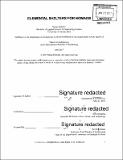Elemental shelters for nomads
Author(s)
Elsholtz, Stefan (Stefan Nathaniel)
DownloadFull printable version (27.40Mb)
Other Contributors
Massachusetts Institute of Technology. Department of Architecture.
Advisor
Azra Akšamija.
Terms of use
Metadata
Show full item recordAbstract
"The Stone Age logic said that the wider and heavier the walls, the more happily secure would be the inhabitants. The advent of metal alloys in the 20th century has brought an abrupt change from structural ponderousness to structural lightness." "[...] As a consequence of the myriad of more-with-less, invisible, technological advances of the 20th century, it is now technically feasible that within 10 years we can have all of humanity enjoying a sustainably higher standard of living-with vastly increased degrees of freedom than has ever been enjoyed by anyone in all history." -R Buckminster Fuller. Last year, as millions of refugees flowed out of Syria fleeing the civil war, the UN Refugee Agency reached out to the Swedish furniture designer Ikea to develop a shelter for refugees called "The Refugee Housing Unit" (RHU). The stated needs for the shelter were structural and material efficiency, low cost, prefabrication, ability to flat pack, built-in solar panels for energy generation, and ease of both assembly and disassembly. The RHU shares all its design functionality with another project, Buckminster Fuller's Dymaxion House of 1929. The Dymaxion House, unlike the RHU, was not intended for refugees but rather rising middle-class Americans looking forward to an ever more modern, prosperous, and mobile lifestyle. Fuller, like many of his contemporaries, believed that the new technological realities of structural lightness and industrial production would usher in a global society free of constraints, a world of modern nomads. Today, as the number of people displaced by war and climate change around the world reaches 60 million for the first time, the modern architect's dream of global freedom is arriving in the form of global vulnerability. Approaches to the issue of shelter, meanwhile, have declined from the energy of projects such as Dymaxion House to the mundaneness of RHU. In my thesis I revisit key works of modern nomadic architecture, testing their relationship to materiality, form, structure, movement, and other parameters, in order to synthesize a series of alternative, speculative shelters addressing the needs of various dispossessed populations today.
Description
Thesis: M. Arch., Massachusetts Institute of Technology, Department of Architecture, 2017. Cataloged from PDF version of thesis. Includes bibliographical references (pages 111-114).
Date issued
2017Department
Massachusetts Institute of Technology. Department of ArchitecturePublisher
Massachusetts Institute of Technology
Keywords
Architecture.